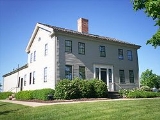
John Johnson Farm
Encyclopedia
The John Johnson farm in Hiram Township
, Portage County
, Ohio
, United States
is a key location in the history
of the Latter Day Saint movement
and The Church of Jesus Christ of Latter-day Saints (LDS Church). Movement founder Joseph Smith, Jr. accepted Johnson's invitation to reside on the farm in September 1831. The farm was the headquarters of Smith's Church of Christ from September 1831 until March 1832, and the farm was the site of several important revelations
to Smith and other church leaders. In 1956, the LDS Church purchased the farm property and used the property as a welfare farm from 1971–2002. The home continues to operate as a tourist attraction.
were received. Among these revelations were section 1, the introduction and section 76, the vision of the degrees of glory
. As part of section 76, Joseph Smith and Sidney Rigdon
stated, "And now, after the many testimonies which have been given of (Jesus Christ), this is the testimony, last of all, which we give of him: That he lives! For we saw him, even on the right hand of God; and we heard the voice bearing record that he is the Only Begotten of the Father--." Joseph Smith also completed part of his revision of the Bible
at the Johnson home.
Hiram Township, Portage County, Ohio
Hiram Township is one of the eighteen townships of Portage County, Ohio, United States. The 2000 census found 2,296 people in the township.-Geography:Located in the northern part of the county, it borders the following other townships:...
, Portage County
Portage County, Ohio
Portage County is a county located in the U.S. state of Ohio. The population was 152,061 at the 2000 Census and 161,419 at the 2010 Census. Its county seat is Ravenna. Portage County is named for the portage between the Cuyahoga and Tuscarawas Rivers...
, Ohio
Ohio
Ohio is a Midwestern state in the United States. The 34th largest state by area in the U.S.,it is the 7th‑most populous with over 11.5 million residents, containing several major American cities and seven metropolitan areas with populations of 500,000 or more.The state's capital is Columbus...
, United States
United States
The United States of America is a federal constitutional republic comprising fifty states and a federal district...
is a key location in the history
History of the Latter Day Saint movement
The Latter Day Saint movement is a religious movement within Christianity that arose during the Second Great Awakening in the early 19th century and that led to the set of doctrines, practices, and cultures called Mormonism and to the existence of numerous Latter Day Saint churches...
of the Latter Day Saint movement
Latter Day Saint movement
The Latter Day Saint movement is a group of independent churches tracing their origin to a Christian primitivist movement founded by Joseph Smith, Jr. in the late 1820s. Collectively, these churches have over 14 million members...
and The Church of Jesus Christ of Latter-day Saints (LDS Church). Movement founder Joseph Smith, Jr. accepted Johnson's invitation to reside on the farm in September 1831. The farm was the headquarters of Smith's Church of Christ from September 1831 until March 1832, and the farm was the site of several important revelations
Revelation (Latter Day Saints)
Latter Day Saints teach that the Latter Day Saint movement began with a Revelation from God . They also teach that revelation is the foundation of the church established by Jesus Christ and that it remains an essential element of His true church today...
to Smith and other church leaders. In 1956, the LDS Church purchased the farm property and used the property as a welfare farm from 1971–2002. The home continues to operate as a tourist attraction.
Revelations received at the Johnson Farm
Several revelations were received by Joseph Smith and other church leaders while at the Johnson Farm. Sixteen of the sections of the Doctrine and CovenantsDoctrine and Covenants
The Doctrine and Covenants is a part of the open scriptural canon of several denominations of the Latter Day Saint movement...
were received. Among these revelations were section 1, the introduction and section 76, the vision of the degrees of glory
Degrees of glory
In The Church of Jesus Christ of Latter-day Saints' theology, there are three degrees of glory which are the ultimate, eternal dwelling place for nearly all who lived on earth after the Spirit world.Joseph Smith, Jr...
. As part of section 76, Joseph Smith and Sidney Rigdon
Sidney Rigdon
Sidney Rigdon was a leader during the early history of the Latter Day Saint movement.-Baptist background:...
stated, "And now, after the many testimonies which have been given of (Jesus Christ), this is the testimony, last of all, which we give of him: That he lives! For we saw him, even on the right hand of God; and we heard the voice bearing record that he is the Only Begotten of the Father--." Joseph Smith also completed part of his revision of the Bible
Joseph Smith Translation of the Bible
The Joseph Smith Translation , also called the Inspired Version , was a revision of the Bible by Joseph Smith, the founder of the Latter Day Saint movement. Smith considered this work to be "a branch of his calling" as a prophet. Smith was murdered before he ever deemed it complete, though most of...
at the Johnson home.

